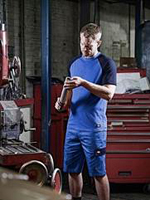A recent study by Dickies Workwear has found a top 10 list of unexpected health and safety rules. It was found that more than 61% of participants experienced a ban on shorts on a construction site, even in the sweltering heat of summer.
The workwear brand, established in 1922, asked and polled their loyal social media followers for the most ludicrous health and safety rules they had come across, and took to the masses to vote on which ones they had also experienced.
Following an interesting range of results, Dickies Workwear made it their mission to myth bust some of the most dubious rules.
Mark Tapper, Head of Ecommerce at Dickies Europe Ltd comments, “over the years we have seen the number of seemingly bizarre rules on sites increase for sure. However, in some occasions, these are perfectly legitimate policies, for example, rules on sleeves may be in place where high visibility is required to ensure the employees have the correct surface area of reflective material to comply with specific EN ISO regulations for the dangerous surroundings.”
The Top 10 Most Ludicrous Health & Safety Rules –
- The ban of shorts (even during summer)
61% of participants experienced a ban on shorts in their site/workplace in the past. Whether workers can wear shorts on a site depends on the site’s policy. If the site policy states that workers must not wear shorts to work, then it’s expected that everyone adheres to the ruling – even if in the sweltering heat of summer.
- Must wash hands after toilet or risk removal from site
14% of participants said that they have been told to wash their hands after going to the toilet or risk removal from site/workplace. Perhaps one of the strangest responses, workers had to wash their hands after the use of the toilet or risk removal from site. (Dickies Workwear are unsure of how this is monitored, nor whose job it is to keep watch on the lavatory usage and hand cleanliness thereafter.)
- Wearing a harness which isn’t attached to anything
Across all industries planning to work at height, the regulation is a maximum of 4 feet before wearing a harness. In construction work, the threshold height is 6 feet above a lower level. Fall protection on scaffolding is required at 10 feet, although a twitter user offered up this rather ludicrous rule that they experienced often in the 90’s.

- A ban of short sleeves
31% of participants have been banned from wearing short sleeves on site. In recent times, more and more construction sites and companies are adopting the “long sleeve PPE” safety policy. This generally refers to the requirement to have all members of the workforce wearing long sleeve shirts when working on site.
- The ban on radios

63% of participants said that they’ve experienced a ban on listening to the radio on site. A highly debated rule in the trades industries, and whilst environment must be taken in to context (building site vs. domestic property), having a radio (or other devices) is now considered to be unsafe, given that it distracts the workers from the task at hand, which often involves them having to concentrate on doing the job properly and safely.
- Hard Hats Aren’t Compulsory
![]()
In the construction industry in the UK, 3% of workers sustain a work-related injury and 11% of these injuries are from being struck by an object. In fact, another 66,000 injuries are estimated to go unreported every year.
While it isn’t 100% compulsory by law to wear a safety helmet on a construction site if there is no risk of head injuries, however, on most construction sites there are dangers so wearing hard hats are necessary.
- The ban of heavy lifting
According to the Health and Safety Executive (HSE), handling, lifting or carrying makes up 20% of non-fatal injuries to employees.
These factors can create excessive stresses and strains on the body. This can cause immediate damage to muscles and tendons such as sprains and pains but can also lead to longer term or recurrent problems. Therefore, it’s in everyone’s best interest to not exceed weight restrictions.
- The ban of stepladders and ladders

It’s a common myth that stepladders and ladders are a health and safety risk. According to HSE this is a myth and stepladders and ladders are not banned, merely a precautionary measure.
- The way hi-vis clothing is worn
One of the respondents was not allowed onsite until his hi-vis vest was completely fastened at the front. According to HSE, around seven workers die and 93 are seriously injured annually by vehicles or mobile plant on construction sites.
And just when you thought you’ve seen it all, perhaps not a legal regulation, but it must’ve been an enforced rule in this workplace…
- Having to deal with bizarre client requests

Perhaps not as much a rule as a standard protocol, but we’ve heard of the term “the client is always right” and so, especially when working in housing sites, it often happens that tenants like to get involved.
Mark Tapper mentions, “If you’re unsure as to why a particular rule may be in place at your place of work I’d recommend speaking to the H&S team, as it is likely that there is a logical explanation.”
For further information on the research conducted, please see Dickies Workwear’s full guide here.

